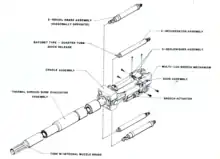M35 (tank gun)
The M35, known during development as the EX35 and XM35,[1][2] is an American 105 mm caliber low-recoil tank gun.
| M35 | |
|---|---|
| Type | Tank gun |
| Place of origin | United States |
| Production history | |
| Designer | Benét Laboratories, Watervliet Arsenal |
| Designed | 1983 |
| Manufacturer | Watervliet Arsenal |
| Specifications | |
| Mass | complete: 2,921 lb (1,325 kg) |
| Cartridge | 105×617mmR |
| Caliber | 105 mm (4.1 in) |


The M35 was developed for the U.S. Army and U.S. Marine Corps Mobile Protected Gun Program of the early 1980s. It was integrated onto the Marine Corps LAV-105, and the U.S. Army's M8 Armored Gun System and M10 Booker vehicles.
History
The M35 was designed and developed by Benét Laboratories, Watervliet Arsenal in 1983 for the Mobile Protected Gun Program,[2] a joint U.S. Marine Corps and U.S. Army program.[3] The program was canceled the following year,[4] however the Large Caliber Weapon System Laboratory (LCWSL) mounted the EX35 in an XM4 Armored Gun System (AGS) turret basket during FY1984. LCWSL fired 100 rounds from the gun.[5]
Armored Gun System
In 1991, the Senate and House Armed Services Committees joined in directing the Army to integrate the turret and Watervliet Arsenal EX35 gun of the LAV-105 with an AGS chassis.[6][7] This joint project never came to fruition.[8] When the Army began its Armored Gun System (AGS) competition in 1991, the Army agreed to furnish the winning bidder with the EX35 gun.[9]
In 1992, the Army selected FMC's Close Combat Vehicle Light as the winner of the AGS competition.[10] United Defense (created by a merger of FMC and BMY) built six prototypes of the CCVL under the designation XM8,[11] later type-classified as the M8.[1] The Army canceled the AGS in 1996 due to budget concerns.[12]
United Defense proposed the AGS to meet the Army's Interim Armored Vehicle requirement, however the Army instead chose General Motors' proposal, later type classified as the Stryker M1128 Mobile Gun System armed with the M68A2.[13]
M10 Booker
In January 2023, an Army report noted unexpectedly "high levels of toxic fumes" from the spent rounds were being vented into the GDLS M10 Booker. The Army's long-term solution is to add a purge system to clear the fumes.[14]
Design

The M35 is about 1,800 lb (816 kg) lighter than the M68 used on the M60 tank.[15]
The XM35 has a bore evacuator. The M35 uses a bore evacuation fan.[16]
References
- Foss, Christopher F., ed. (1997). "Light Tanks". Jane's Armour and Artillery 1997–98 (18th ed.). Surrey: Jane's Information Group. pp. 171–173. ISBN 978-0-71061-542-8.
- Freeman, Major Marshall A. (April 5, 1991). The Army Needs a Strategic Armored Gun System—Now! (PDF) (War College Individual Study Project). U.S. Army War College, Carlisle Barracks. pp. 23–24. Archived (PDF) from the original on May 12, 2022. Retrieved March 10, 2022.
- Foss, Christopher F., ed. (1985). "Light Tanks". Jane's Armour and Artillery 1985–86 (6th ed.). London: Jane's Publishing Company. p. 152. ISBN 0-7106-0820-9.
- Hunnicutt 2015a, p. 165.
- Large Caliber Weapon System Laboratory (1984). Technical Accomplishments in FY 1984 (Report). Army Material Command. p. 11. Retrieved April 23, 2023.
- "Army, Marine Corps Told to Join Forces and Develop New Armored Vehicle". Inside the Pentagon. Vol. 7, no. 30. Inside Washington Publishers. July 25, 1991. p. 5. JSTOR 43987311.
- "Marines reject Hill advice on LAV-105 turret; SASC and HASC support common turret". Defense Daily. Vol. 172, no. 28. Access Intelligence. August 8, 1991. Archived from the original on January 15, 2023. Retrieved August 5, 2022.
- "Senate Appropriators Say: Army Does Not Have Funding to Follow Through With Force Modernization Plans". Inside the Pentagon. Vol. 7, no. 39. Inside Washington Publishers. September 26, 1991. p. 12. JSTOR 43989173.
- Wank, Lieutenant James A. (April 15, 1993). The Armored Gun System – An Acquisition Streamlining Model for the U.S. Army? (PDF) (Personal study). U.S. Army War College. pp. 23–24. Archived (PDF) from the original on June 2, 2022. Retrieved June 1, 2022.
- "FMC Selected to Build Armored Gun System: Army's AGS to Feature All-Welded Aluminum Hull, Detroit Diesel Engine". Inside the Pentagon. Vol. 8, no. 24. Inside Washington Publishers. June 11, 1992. p. 13. JSTOR 43988110.
- Hunnicutt 2015a, p. 183.
- Sherman, Jason (February 12, 1996). "Service Still Seeking OSD Support: Army's Decision to Terminate AGS Meets Stiff Resistance on Capitol Hill". Inside the Army. Vol. 8, no. 6. Inside Washington Publishers. pp. 1, 9–10. JSTOR 43982648.
- "M8 Armored Gun System – Archived 3/2004". www.forecastinternational.com. Forecast International. Archived from the original on March 28, 2019. Retrieved March 28, 2019.
- Roque, Ashley (February 2, 2023). "Army working to fix Mobile Protected Firepower toxic fume issue". Breaking Defense. Breaking Media. Retrieved April 25, 2023.
- "Armored Gun System Loses Weight to Be Deployed by C-130". Inside the Pentagon. Vol. 9, no. 31. Inside Washington Publishers. August 5, 1993. JSTOR 43990667.
- LTC George. Inside the Chieftain's Hatch: BAE XM1302, Part 1 (Video). Retrieved June 24, 2023.
Sources
- Hunnicutt, Richard Pearce (2015a) [1995]. Sheridan: A History of the American Light Tank. Vol. 2. Battleboro, VT: Echo Point Books & Media. ISBN 978-1-62654-154-2.